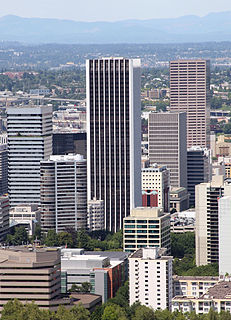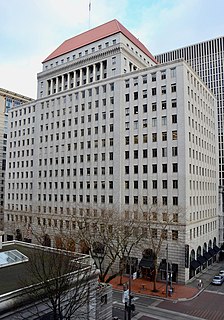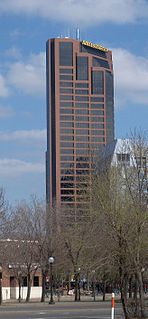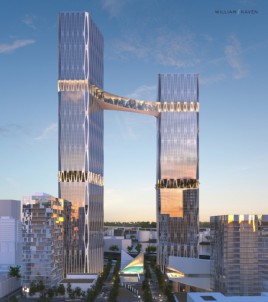
Portland architecture includes a number of notable buildings, a wide range of styles, and a few notable pioneering architects.

Wells Fargo Center is a 40-story, 166.4 m (546 ft) tower and a five-story adjacent office building with three levels of parking below the surface in Portland, Oregon. The tower became the tallest building in the state of Oregon when it was completed in 1972.

The U.S. Bancorp Tower is a 42-story, 163.38 m (536.0 ft) skyscraper in Portland, Oregon. It is the second tallest building in the city after Wells Fargo Center, and with its nearly 69,000 m2 (740,000 sq ft) office space, it is the largest in Oregon in terms of volume. In October 2019, the building was awarded the Leadership in Energy and Environmental Design Platinum certification for environmental sustainability by the U.S. Green Building Council.

The Meier & Frank Building is a fifteen-story, glazed terra cotta building located in downtown Portland, Oregon, across from the northeast corner of Pioneer Courthouse Square. The building is the former flagship store and headquarters building for the Meier & Frank department store chain, which was taken over by Macy's in 2006. In 2006–2007, the building's lower floors were remodeled into an updated Macy's department store, while the upper floors were renovated in 2008 into a luxury hotel known as The Nines. In 2016, Macy's announced that it planned to close the store in spring 2017, and the store closed in April 2017.

20 Exchange Place is a skyscraper in the Financial District of Lower Manhattan in New York City. Completed in 1931, it was designed by Cross & Cross in the Art Deco style as the headquarters of the City Bank–Farmers Trust Company, predecessor of Citigroup. The building, standing at approximately 741 feet (226 m) with 57 usable stories, was one of the city's tallest buildings and the world's tallest stone-clad building at the time of its completion. While 20 Exchange Place was intended to be the world's tallest building at the time of its construction, the Great Depression resulted in the current scaled-back plan.

Republic Center is a mixed-use complex at 300 N. Ervay Street and 325 N. St. Paul Street in the City Center District of downtown Dallas, Texas (USA), adjacent to Thanks-giving Square. The complex is located diagonally across the street from DART's St. Paul Station, which serves its Blue, Red, Orange, and Green light rail lines. It also contains part of the Dallas Pedestrian Network, with shops and restaurants in the lower levels of the building and is connected to the Bullington Truck Terminal.

The Bank of California Building, also known as the Durham & Bates Building and currently the Three Kings Building, is a historic former bank building in downtown Portland, Oregon, United States. It has been on the National Register of Historic Places since 1978. The three-story building was designed by A. E. Doyle in an Italianate style and completed in 1925. The ground floor features a two-story-high grand room with 36-foot (11 m) ceilings. The building's original owner and occupant, the Bank of California, moved out around the end of 1969 and sold the building in 1970. It has had a succession of other owners and tenants since then. It was last used as a bank in 1977.

The Public Service Building is a historic 67.06 m (220.0 ft), 15-story office building in downtown Portland, Oregon, United States. The building and its attached parking garage have been listed on the National Register of Historic Places as the Public Service Building and Garage since 1996. It was built to house the offices of the Portland Gas and Coke Company and the Pacific Power and Light Company. The building's name reflects the fact that these utilities were "public services". A space in the Public Service Building fronting the corner of Salmon and Sixth streets became the first Niketown store.

Portland City Hall is the headquarters of city government of Portland, Oregon, United States. The four-story Italian Renaissance-style building houses the offices of the City Council, which consists of the mayor and four commissioners, and several other offices. City Hall is also home to the City Council chambers, located in the rotunda on the east side of the structure. Completed in 1895, the building was added to the National Register of Historic Places on November 21, 1974. City Hall has gone through several renovations, with the most recent overhaul gutting the interior to upgrade it to modern seismic and safety standards. The original was built for $600,000, while the 1996 to 1998 renovation cost $29 million.
The architecture of the U.S. state of Texas comes from a wide variety of sources. Many of the state's buildings reflect Texas' Spanish and Mexican roots; in addition, there is considerable influence from mostly the American South as well as the Southwest. Rapid economic growth since the mid twentieth century has led to a wide variety of contemporary architectural buildings.

Wells Fargo Place is an office tower in St. Paul, Minnesota, United States. It stands at 471 feet (144 m) tall, and is currently the tallest building in St. Paul. It was designed by Winsor/Faricy Architects, Inc. and WZMH Architects, and is 37 stories tall. The building opened in September 1987, a month ahead of schedule and under budget. It is a concrete and steel structure, with a facade of brown-colored granite and glass. The granite came from Finland. The building contains 156 underground parking spaces. It was formerly known as The Minnesota World Trade Center. Anthrosphere, a large sculpture by Paul Granlund, is in the lobby.

The First National Bank Building is a building located in downtown Portland, Oregon, listed on the National Register of Historic Places.

The United States National Bank Building in downtown Portland, Oregon, is listed on the National Register of Historic Places. Designed by famed Portland architect A. E. Doyle in a Roman classical style, the four-story building's first section, facing Sixth Avenue, was completed and opened in 1917. An extension westward to Broadway, approximately doubling its size, was constructed in 1925. Since then the building has occupied one-half of a city block. It features a four-story-high colonnade of Corinthian order columns at its eastern end, originally the principal façade, and extensive use of glazed terracotta. The interior is also decorated extensively with highly textured materials. The building was constructed for the United States National Bank of Portland (USNB), which ultimately became part of U.S. Bancorp, whose retail banking division operates as U.S. Bank. In 2020, more than 100 years after the building's opening, it continues to serve as the bank's main Portland branch.

Standard Plaza is a 16-story office building in downtown Portland in the U.S. state of Oregon. At 222 feet (68 m) in height, it was the largest office building in Oregon when it was completed in 1963. The 217,000-square-foot (20,200 m2) structure, occupying a city block on SW 6th Avenue between Main Street and Madison Street, is owned by Standard Insurance Company, which also owns the neighboring Standard Insurance Center. It was designed by Skidmore, Owings and Merrill in the international style.

400 SW Sixth Avenue is an eleven-story office building in Downtown Portland in the U.S. state of Oregon. Originally known as the First National Bank Building, it opened in 1960 as a six-story bank building. The 139-foot (42 m) tall mid-rise contains 216,108 square feet (20,077.1 m2) of space, with retail on the ground floor. From 1995 to 2016 the primary retail tenant was Camera World.

The Oregonian Building was a building in downtown Portland, Oregon, United States, which served as the headquarters of Portland's major newspaper, The Oregonian, from 1892 to 1948. It was the first steel-framed building constructed in the Western U.S., and from its opening until 1911 it was the tallest building in Portland. In addition to the newspaper's offices and printing press, in 1922 the building became the home of Portland's first commercial radio station, KGW, which was owned by the Oregonian Publishing Company. A second radio station, KEX, was acquired by the paper in 1933, and joined KGW in new, shared studios in the Oregonian Building. A fire in 1943 forced the radio stations to relocate. The company sold the building in December 1947 as it prepared for a move to a larger building. In June 1948, the newspaper moved to a new building on Southwest Broadway, also called the Oregonian Building. The 1892 building with the landmark clock tower then stood vacant for about two years until it was demolished, in 1950.

The "Twin Towers" was a proposed mixed-use skyscraper complex in the Pearl District of Portland, Oregon. Multi-disciplinary architecture firm William Kaven Architecture proposed the complex as a potential part of the Broadway Corridor redevelopment project. The twin-towered skyscrapers would reach 970 feet (300 m) in height and would have become the tallest building in Oregon, the tallest twin towers in the Western Hemisphere and fifth-tallest in the world. A significant obstacle to the proposal was that current zoning at the site limits building heights to 400 feet (120 m). The proposal was not among the list of three finalists chosen by Prosper Portland in March 2018.


















